Creative Cross Curricular Approaches and Learning Beyond the Classroom
VerifiedAdded on 2022/12/26
|14
|5229
|3
Essay
AI Summary
This essay delves into the realm of education, focusing on enhancing learning through creative cross-curricular approaches and extending the learning environment beyond the traditional classroom setting. The introduction establishes the concepts of teaching and learning, emphasizing the interaction of variables to achieve educational goals. It introduces cross-curricular approaches as a means to connect different disciplines, fostering collaboration and critical thinking. The essay highlights the significance of learning beyond the classroom and the impact of online teaching. The main body explores various topics, including poetry analogy, programming, and pattern hunt, linking them to different pedagogies like discovery, reflective, and collaborative approaches. It discusses the differences between cross-curricular and discrete teaching methods, providing examples of how subjects can be integrated or taught independently. The essay further examines creative learning and teaching strategies, presents arguments for and against cross-curricular teaching, and discusses different learning approaches such as direct instruction and inquiry-based learning. The essay also includes the importance of curriculum development and the application of transferable skills across different subjects, such as history, math, and drama, to enhance learners' understanding. It also discusses the benefits and limitations of online teaching.

Enhancing learning through creative
cross curricular approaches and
working beyond the classroom
cross curricular approaches and
working beyond the classroom
Paraphrase This Document
Need a fresh take? Get an instant paraphrase of this document with our AI Paraphraser
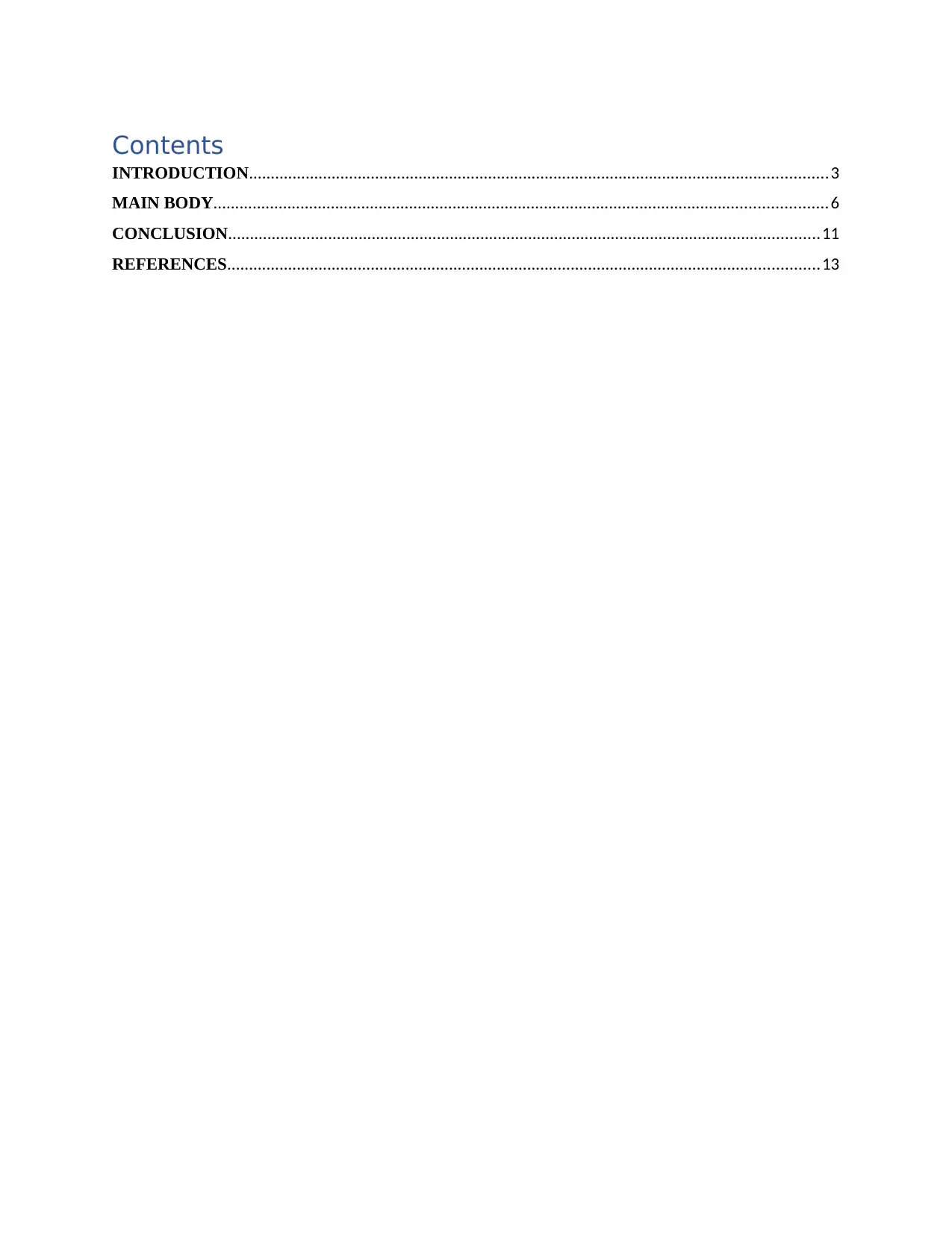
Contents
INTRODUCTION.....................................................................................................................................3
MAIN BODY.............................................................................................................................................6
CONCLUSION........................................................................................................................................11
REFERENCES........................................................................................................................................13
INTRODUCTION.....................................................................................................................................3
MAIN BODY.............................................................................................................................................6
CONCLUSION........................................................................................................................................11
REFERENCES........................................................................................................................................13
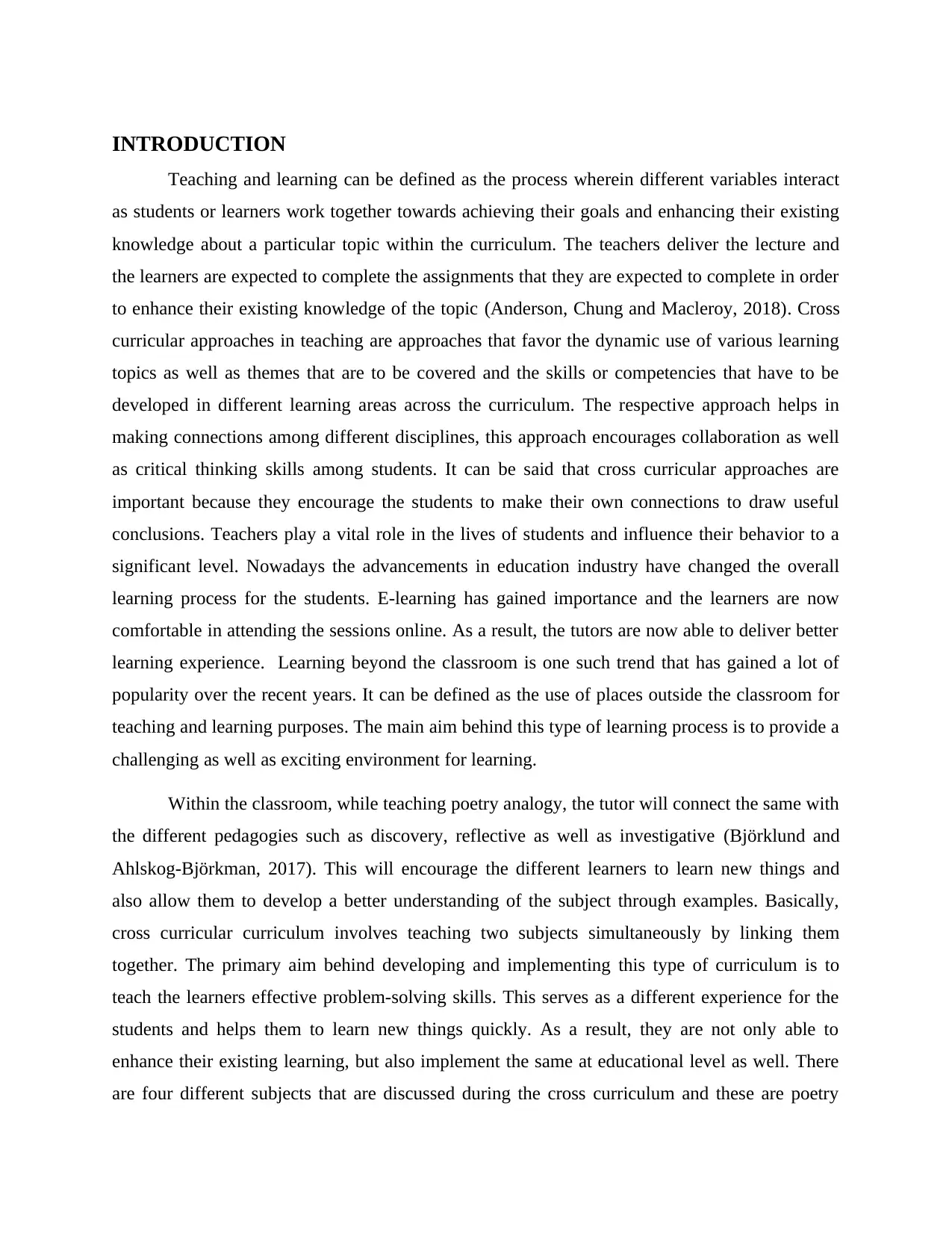
INTRODUCTION
Teaching and learning can be defined as the process wherein different variables interact
as students or learners work together towards achieving their goals and enhancing their existing
knowledge about a particular topic within the curriculum. The teachers deliver the lecture and
the learners are expected to complete the assignments that they are expected to complete in order
to enhance their existing knowledge of the topic (Anderson, Chung and Macleroy, 2018). Cross
curricular approaches in teaching are approaches that favor the dynamic use of various learning
topics as well as themes that are to be covered and the skills or competencies that have to be
developed in different learning areas across the curriculum. The respective approach helps in
making connections among different disciplines, this approach encourages collaboration as well
as critical thinking skills among students. It can be said that cross curricular approaches are
important because they encourage the students to make their own connections to draw useful
conclusions. Teachers play a vital role in the lives of students and influence their behavior to a
significant level. Nowadays the advancements in education industry have changed the overall
learning process for the students. E-learning has gained importance and the learners are now
comfortable in attending the sessions online. As a result, the tutors are now able to deliver better
learning experience. Learning beyond the classroom is one such trend that has gained a lot of
popularity over the recent years. It can be defined as the use of places outside the classroom for
teaching and learning purposes. The main aim behind this type of learning process is to provide a
challenging as well as exciting environment for learning.
Within the classroom, while teaching poetry analogy, the tutor will connect the same with
the different pedagogies such as discovery, reflective as well as investigative (Björklund and
Ahlskog-Björkman, 2017). This will encourage the different learners to learn new things and
also allow them to develop a better understanding of the subject through examples. Basically,
cross curricular curriculum involves teaching two subjects simultaneously by linking them
together. The primary aim behind developing and implementing this type of curriculum is to
teach the learners effective problem-solving skills. This serves as a different experience for the
students and helps them to learn new things quickly. As a result, they are not only able to
enhance their existing learning, but also implement the same at educational level as well. There
are four different subjects that are discussed during the cross curriculum and these are poetry
Teaching and learning can be defined as the process wherein different variables interact
as students or learners work together towards achieving their goals and enhancing their existing
knowledge about a particular topic within the curriculum. The teachers deliver the lecture and
the learners are expected to complete the assignments that they are expected to complete in order
to enhance their existing knowledge of the topic (Anderson, Chung and Macleroy, 2018). Cross
curricular approaches in teaching are approaches that favor the dynamic use of various learning
topics as well as themes that are to be covered and the skills or competencies that have to be
developed in different learning areas across the curriculum. The respective approach helps in
making connections among different disciplines, this approach encourages collaboration as well
as critical thinking skills among students. It can be said that cross curricular approaches are
important because they encourage the students to make their own connections to draw useful
conclusions. Teachers play a vital role in the lives of students and influence their behavior to a
significant level. Nowadays the advancements in education industry have changed the overall
learning process for the students. E-learning has gained importance and the learners are now
comfortable in attending the sessions online. As a result, the tutors are now able to deliver better
learning experience. Learning beyond the classroom is one such trend that has gained a lot of
popularity over the recent years. It can be defined as the use of places outside the classroom for
teaching and learning purposes. The main aim behind this type of learning process is to provide a
challenging as well as exciting environment for learning.
Within the classroom, while teaching poetry analogy, the tutor will connect the same with
the different pedagogies such as discovery, reflective as well as investigative (Björklund and
Ahlskog-Björkman, 2017). This will encourage the different learners to learn new things and
also allow them to develop a better understanding of the subject through examples. Basically,
cross curricular curriculum involves teaching two subjects simultaneously by linking them
together. The primary aim behind developing and implementing this type of curriculum is to
teach the learners effective problem-solving skills. This serves as a different experience for the
students and helps them to learn new things quickly. As a result, they are not only able to
enhance their existing learning, but also implement the same at educational level as well. There
are four different subjects that are discussed during the cross curriculum and these are poetry
⊘ This is a preview!⊘
Do you want full access?
Subscribe today to unlock all pages.

Trusted by 1+ million students worldwide
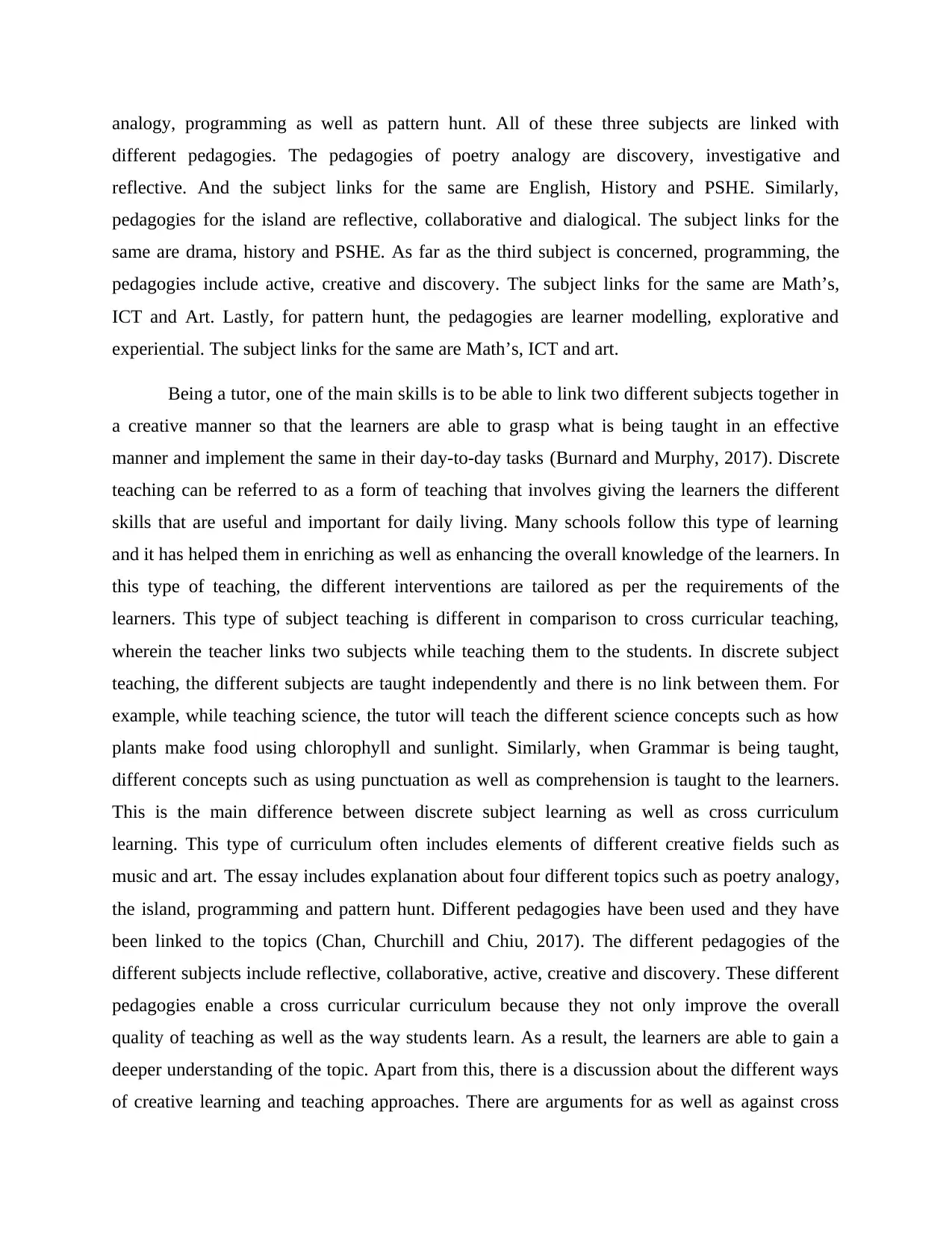
analogy, programming as well as pattern hunt. All of these three subjects are linked with
different pedagogies. The pedagogies of poetry analogy are discovery, investigative and
reflective. And the subject links for the same are English, History and PSHE. Similarly,
pedagogies for the island are reflective, collaborative and dialogical. The subject links for the
same are drama, history and PSHE. As far as the third subject is concerned, programming, the
pedagogies include active, creative and discovery. The subject links for the same are Math’s,
ICT and Art. Lastly, for pattern hunt, the pedagogies are learner modelling, explorative and
experiential. The subject links for the same are Math’s, ICT and art.
Being a tutor, one of the main skills is to be able to link two different subjects together in
a creative manner so that the learners are able to grasp what is being taught in an effective
manner and implement the same in their day-to-day tasks (Burnard and Murphy, 2017). Discrete
teaching can be referred to as a form of teaching that involves giving the learners the different
skills that are useful and important for daily living. Many schools follow this type of learning
and it has helped them in enriching as well as enhancing the overall knowledge of the learners. In
this type of teaching, the different interventions are tailored as per the requirements of the
learners. This type of subject teaching is different in comparison to cross curricular teaching,
wherein the teacher links two subjects while teaching them to the students. In discrete subject
teaching, the different subjects are taught independently and there is no link between them. For
example, while teaching science, the tutor will teach the different science concepts such as how
plants make food using chlorophyll and sunlight. Similarly, when Grammar is being taught,
different concepts such as using punctuation as well as comprehension is taught to the learners.
This is the main difference between discrete subject learning as well as cross curriculum
learning. This type of curriculum often includes elements of different creative fields such as
music and art. The essay includes explanation about four different topics such as poetry analogy,
the island, programming and pattern hunt. Different pedagogies have been used and they have
been linked to the topics (Chan, Churchill and Chiu, 2017). The different pedagogies of the
different subjects include reflective, collaborative, active, creative and discovery. These different
pedagogies enable a cross curricular curriculum because they not only improve the overall
quality of teaching as well as the way students learn. As a result, the learners are able to gain a
deeper understanding of the topic. Apart from this, there is a discussion about the different ways
of creative learning and teaching approaches. There are arguments for as well as against cross
different pedagogies. The pedagogies of poetry analogy are discovery, investigative and
reflective. And the subject links for the same are English, History and PSHE. Similarly,
pedagogies for the island are reflective, collaborative and dialogical. The subject links for the
same are drama, history and PSHE. As far as the third subject is concerned, programming, the
pedagogies include active, creative and discovery. The subject links for the same are Math’s,
ICT and Art. Lastly, for pattern hunt, the pedagogies are learner modelling, explorative and
experiential. The subject links for the same are Math’s, ICT and art.
Being a tutor, one of the main skills is to be able to link two different subjects together in
a creative manner so that the learners are able to grasp what is being taught in an effective
manner and implement the same in their day-to-day tasks (Burnard and Murphy, 2017). Discrete
teaching can be referred to as a form of teaching that involves giving the learners the different
skills that are useful and important for daily living. Many schools follow this type of learning
and it has helped them in enriching as well as enhancing the overall knowledge of the learners. In
this type of teaching, the different interventions are tailored as per the requirements of the
learners. This type of subject teaching is different in comparison to cross curricular teaching,
wherein the teacher links two subjects while teaching them to the students. In discrete subject
teaching, the different subjects are taught independently and there is no link between them. For
example, while teaching science, the tutor will teach the different science concepts such as how
plants make food using chlorophyll and sunlight. Similarly, when Grammar is being taught,
different concepts such as using punctuation as well as comprehension is taught to the learners.
This is the main difference between discrete subject learning as well as cross curriculum
learning. This type of curriculum often includes elements of different creative fields such as
music and art. The essay includes explanation about four different topics such as poetry analogy,
the island, programming and pattern hunt. Different pedagogies have been used and they have
been linked to the topics (Chan, Churchill and Chiu, 2017). The different pedagogies of the
different subjects include reflective, collaborative, active, creative and discovery. These different
pedagogies enable a cross curricular curriculum because they not only improve the overall
quality of teaching as well as the way students learn. As a result, the learners are able to gain a
deeper understanding of the topic. Apart from this, there is a discussion about the different ways
of creative learning and teaching approaches. There are arguments for as well as against cross
Paraphrase This Document
Need a fresh take? Get an instant paraphrase of this document with our AI Paraphraser
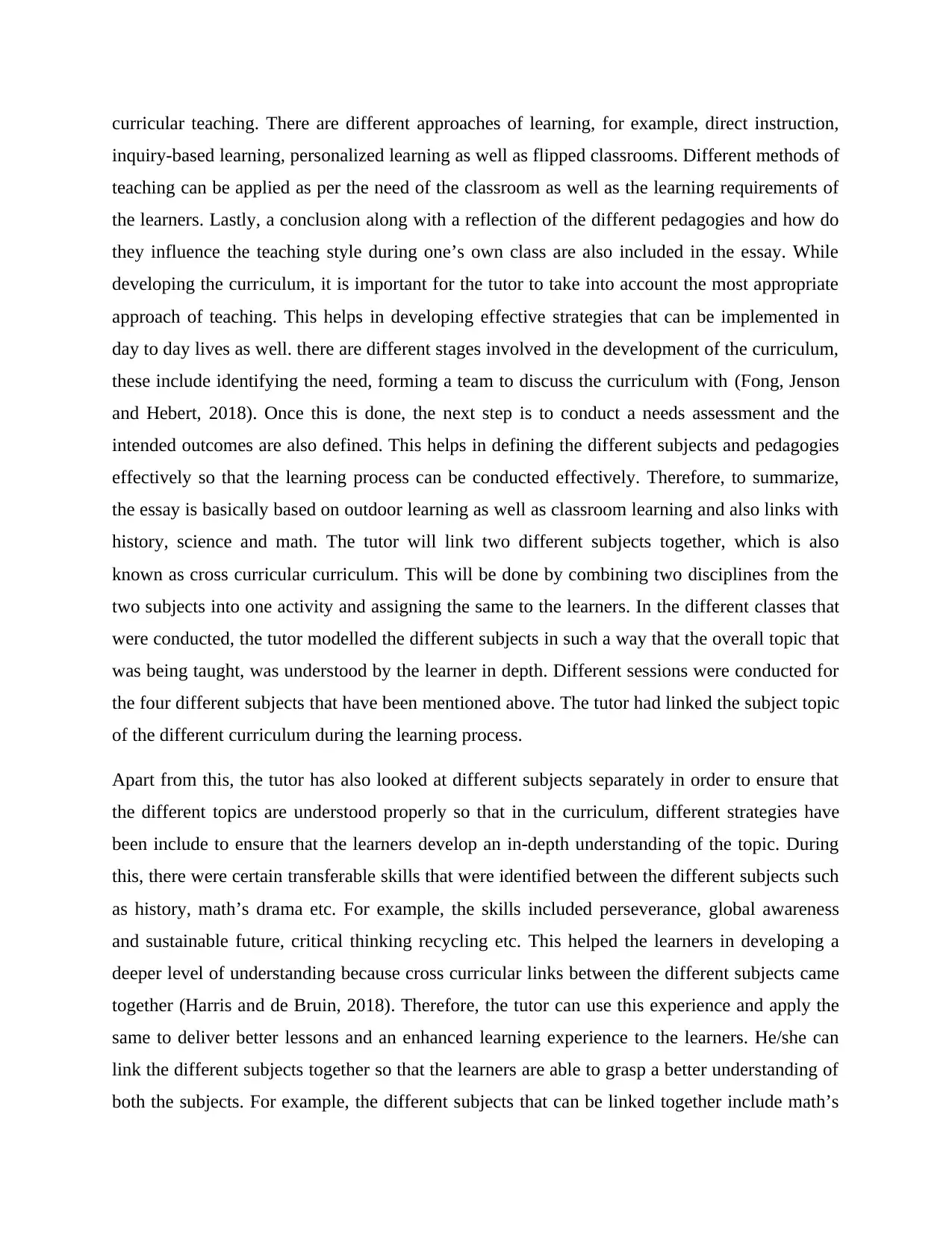
curricular teaching. There are different approaches of learning, for example, direct instruction,
inquiry-based learning, personalized learning as well as flipped classrooms. Different methods of
teaching can be applied as per the need of the classroom as well as the learning requirements of
the learners. Lastly, a conclusion along with a reflection of the different pedagogies and how do
they influence the teaching style during one’s own class are also included in the essay. While
developing the curriculum, it is important for the tutor to take into account the most appropriate
approach of teaching. This helps in developing effective strategies that can be implemented in
day to day lives as well. there are different stages involved in the development of the curriculum,
these include identifying the need, forming a team to discuss the curriculum with (Fong, Jenson
and Hebert, 2018). Once this is done, the next step is to conduct a needs assessment and the
intended outcomes are also defined. This helps in defining the different subjects and pedagogies
effectively so that the learning process can be conducted effectively. Therefore, to summarize,
the essay is basically based on outdoor learning as well as classroom learning and also links with
history, science and math. The tutor will link two different subjects together, which is also
known as cross curricular curriculum. This will be done by combining two disciplines from the
two subjects into one activity and assigning the same to the learners. In the different classes that
were conducted, the tutor modelled the different subjects in such a way that the overall topic that
was being taught, was understood by the learner in depth. Different sessions were conducted for
the four different subjects that have been mentioned above. The tutor had linked the subject topic
of the different curriculum during the learning process.
Apart from this, the tutor has also looked at different subjects separately in order to ensure that
the different topics are understood properly so that in the curriculum, different strategies have
been include to ensure that the learners develop an in-depth understanding of the topic. During
this, there were certain transferable skills that were identified between the different subjects such
as history, math’s drama etc. For example, the skills included perseverance, global awareness
and sustainable future, critical thinking recycling etc. This helped the learners in developing a
deeper level of understanding because cross curricular links between the different subjects came
together (Harris and de Bruin, 2018). Therefore, the tutor can use this experience and apply the
same to deliver better lessons and an enhanced learning experience to the learners. He/she can
link the different subjects together so that the learners are able to grasp a better understanding of
both the subjects. For example, the different subjects that can be linked together include math’s
inquiry-based learning, personalized learning as well as flipped classrooms. Different methods of
teaching can be applied as per the need of the classroom as well as the learning requirements of
the learners. Lastly, a conclusion along with a reflection of the different pedagogies and how do
they influence the teaching style during one’s own class are also included in the essay. While
developing the curriculum, it is important for the tutor to take into account the most appropriate
approach of teaching. This helps in developing effective strategies that can be implemented in
day to day lives as well. there are different stages involved in the development of the curriculum,
these include identifying the need, forming a team to discuss the curriculum with (Fong, Jenson
and Hebert, 2018). Once this is done, the next step is to conduct a needs assessment and the
intended outcomes are also defined. This helps in defining the different subjects and pedagogies
effectively so that the learning process can be conducted effectively. Therefore, to summarize,
the essay is basically based on outdoor learning as well as classroom learning and also links with
history, science and math. The tutor will link two different subjects together, which is also
known as cross curricular curriculum. This will be done by combining two disciplines from the
two subjects into one activity and assigning the same to the learners. In the different classes that
were conducted, the tutor modelled the different subjects in such a way that the overall topic that
was being taught, was understood by the learner in depth. Different sessions were conducted for
the four different subjects that have been mentioned above. The tutor had linked the subject topic
of the different curriculum during the learning process.
Apart from this, the tutor has also looked at different subjects separately in order to ensure that
the different topics are understood properly so that in the curriculum, different strategies have
been include to ensure that the learners develop an in-depth understanding of the topic. During
this, there were certain transferable skills that were identified between the different subjects such
as history, math’s drama etc. For example, the skills included perseverance, global awareness
and sustainable future, critical thinking recycling etc. This helped the learners in developing a
deeper level of understanding because cross curricular links between the different subjects came
together (Harris and de Bruin, 2018). Therefore, the tutor can use this experience and apply the
same to deliver better lessons and an enhanced learning experience to the learners. He/she can
link the different subjects together so that the learners are able to grasp a better understanding of
both the subjects. For example, the different subjects that can be linked together include math’s
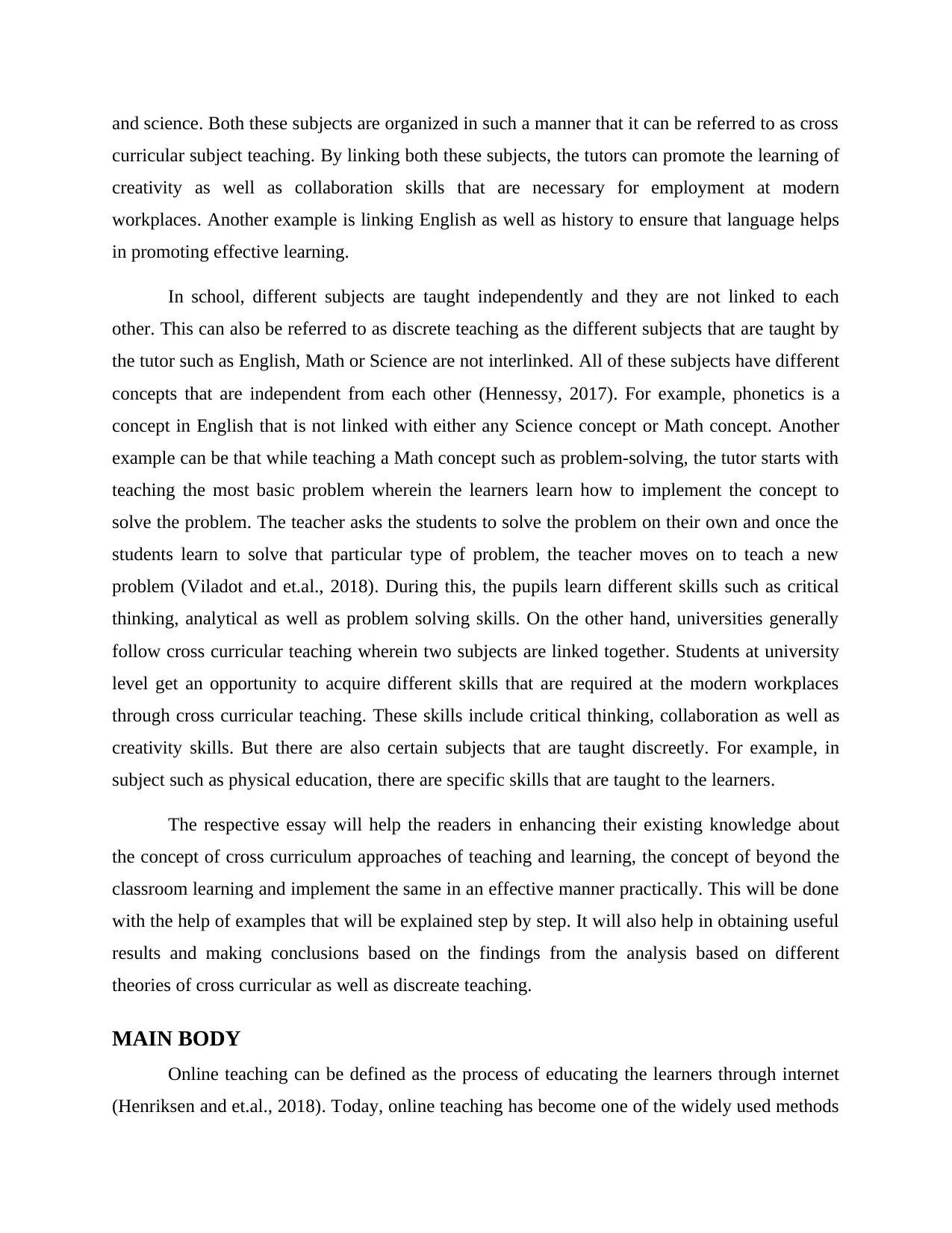
and science. Both these subjects are organized in such a manner that it can be referred to as cross
curricular subject teaching. By linking both these subjects, the tutors can promote the learning of
creativity as well as collaboration skills that are necessary for employment at modern
workplaces. Another example is linking English as well as history to ensure that language helps
in promoting effective learning.
In school, different subjects are taught independently and they are not linked to each
other. This can also be referred to as discrete teaching as the different subjects that are taught by
the tutor such as English, Math or Science are not interlinked. All of these subjects have different
concepts that are independent from each other (Hennessy, 2017). For example, phonetics is a
concept in English that is not linked with either any Science concept or Math concept. Another
example can be that while teaching a Math concept such as problem-solving, the tutor starts with
teaching the most basic problem wherein the learners learn how to implement the concept to
solve the problem. The teacher asks the students to solve the problem on their own and once the
students learn to solve that particular type of problem, the teacher moves on to teach a new
problem (Viladot and et.al., 2018). During this, the pupils learn different skills such as critical
thinking, analytical as well as problem solving skills. On the other hand, universities generally
follow cross curricular teaching wherein two subjects are linked together. Students at university
level get an opportunity to acquire different skills that are required at the modern workplaces
through cross curricular teaching. These skills include critical thinking, collaboration as well as
creativity skills. But there are also certain subjects that are taught discreetly. For example, in
subject such as physical education, there are specific skills that are taught to the learners.
The respective essay will help the readers in enhancing their existing knowledge about
the concept of cross curriculum approaches of teaching and learning, the concept of beyond the
classroom learning and implement the same in an effective manner practically. This will be done
with the help of examples that will be explained step by step. It will also help in obtaining useful
results and making conclusions based on the findings from the analysis based on different
theories of cross curricular as well as discreate teaching.
MAIN BODY
Online teaching can be defined as the process of educating the learners through internet
(Henriksen and et.al., 2018). Today, online teaching has become one of the widely used methods
curricular subject teaching. By linking both these subjects, the tutors can promote the learning of
creativity as well as collaboration skills that are necessary for employment at modern
workplaces. Another example is linking English as well as history to ensure that language helps
in promoting effective learning.
In school, different subjects are taught independently and they are not linked to each
other. This can also be referred to as discrete teaching as the different subjects that are taught by
the tutor such as English, Math or Science are not interlinked. All of these subjects have different
concepts that are independent from each other (Hennessy, 2017). For example, phonetics is a
concept in English that is not linked with either any Science concept or Math concept. Another
example can be that while teaching a Math concept such as problem-solving, the tutor starts with
teaching the most basic problem wherein the learners learn how to implement the concept to
solve the problem. The teacher asks the students to solve the problem on their own and once the
students learn to solve that particular type of problem, the teacher moves on to teach a new
problem (Viladot and et.al., 2018). During this, the pupils learn different skills such as critical
thinking, analytical as well as problem solving skills. On the other hand, universities generally
follow cross curricular teaching wherein two subjects are linked together. Students at university
level get an opportunity to acquire different skills that are required at the modern workplaces
through cross curricular teaching. These skills include critical thinking, collaboration as well as
creativity skills. But there are also certain subjects that are taught discreetly. For example, in
subject such as physical education, there are specific skills that are taught to the learners.
The respective essay will help the readers in enhancing their existing knowledge about
the concept of cross curriculum approaches of teaching and learning, the concept of beyond the
classroom learning and implement the same in an effective manner practically. This will be done
with the help of examples that will be explained step by step. It will also help in obtaining useful
results and making conclusions based on the findings from the analysis based on different
theories of cross curricular as well as discreate teaching.
MAIN BODY
Online teaching can be defined as the process of educating the learners through internet
(Henriksen and et.al., 2018). Today, online teaching has become one of the widely used methods
⊘ This is a preview!⊘
Do you want full access?
Subscribe today to unlock all pages.

Trusted by 1+ million students worldwide
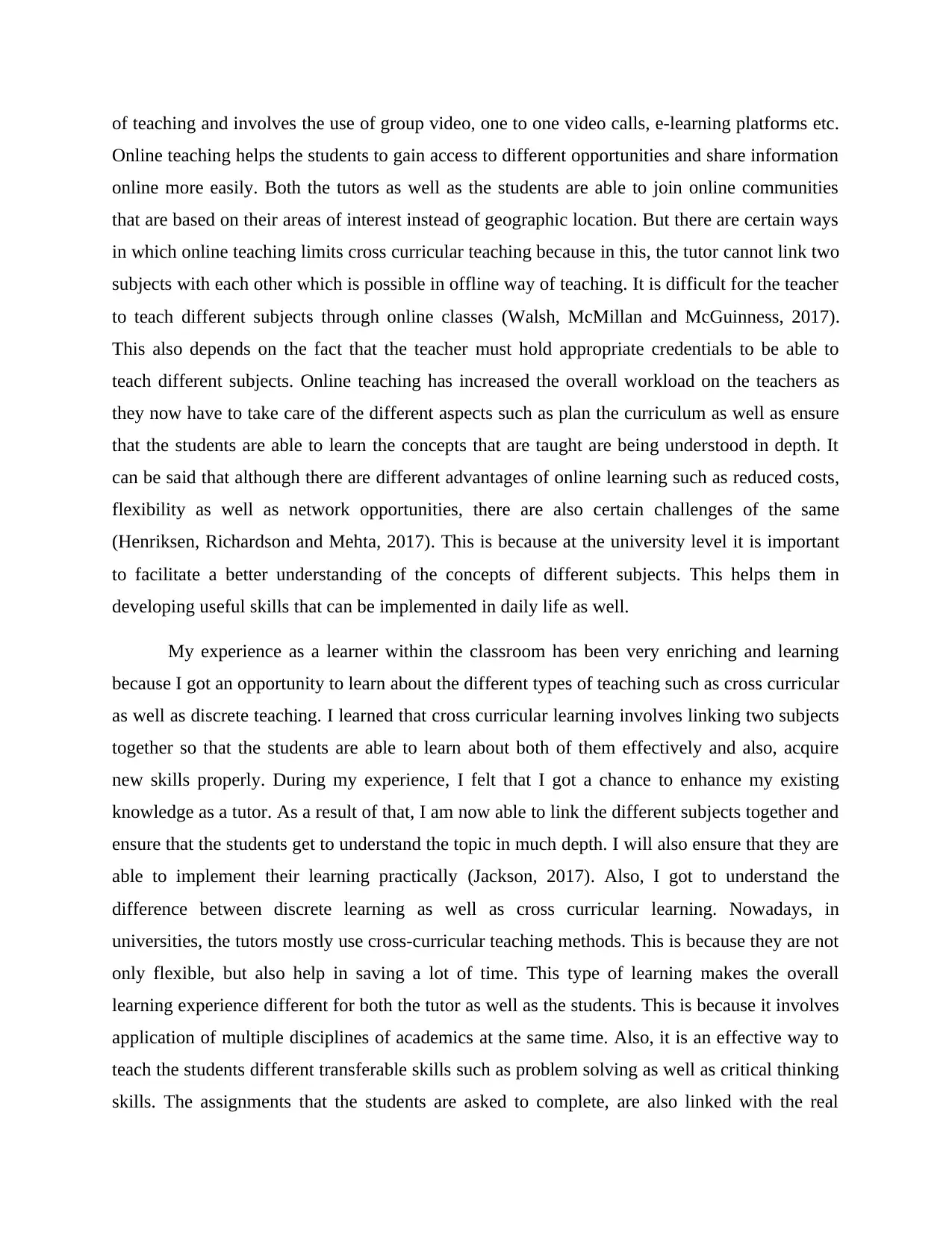
of teaching and involves the use of group video, one to one video calls, e-learning platforms etc.
Online teaching helps the students to gain access to different opportunities and share information
online more easily. Both the tutors as well as the students are able to join online communities
that are based on their areas of interest instead of geographic location. But there are certain ways
in which online teaching limits cross curricular teaching because in this, the tutor cannot link two
subjects with each other which is possible in offline way of teaching. It is difficult for the teacher
to teach different subjects through online classes (Walsh, McMillan and McGuinness, 2017).
This also depends on the fact that the teacher must hold appropriate credentials to be able to
teach different subjects. Online teaching has increased the overall workload on the teachers as
they now have to take care of the different aspects such as plan the curriculum as well as ensure
that the students are able to learn the concepts that are taught are being understood in depth. It
can be said that although there are different advantages of online learning such as reduced costs,
flexibility as well as network opportunities, there are also certain challenges of the same
(Henriksen, Richardson and Mehta, 2017). This is because at the university level it is important
to facilitate a better understanding of the concepts of different subjects. This helps them in
developing useful skills that can be implemented in daily life as well.
My experience as a learner within the classroom has been very enriching and learning
because I got an opportunity to learn about the different types of teaching such as cross curricular
as well as discrete teaching. I learned that cross curricular learning involves linking two subjects
together so that the students are able to learn about both of them effectively and also, acquire
new skills properly. During my experience, I felt that I got a chance to enhance my existing
knowledge as a tutor. As a result of that, I am now able to link the different subjects together and
ensure that the students get to understand the topic in much depth. I will also ensure that they are
able to implement their learning practically (Jackson, 2017). Also, I got to understand the
difference between discrete learning as well as cross curricular learning. Nowadays, in
universities, the tutors mostly use cross-curricular teaching methods. This is because they are not
only flexible, but also help in saving a lot of time. This type of learning makes the overall
learning experience different for both the tutor as well as the students. This is because it involves
application of multiple disciplines of academics at the same time. Also, it is an effective way to
teach the students different transferable skills such as problem solving as well as critical thinking
skills. The assignments that the students are asked to complete, are also linked with the real
Online teaching helps the students to gain access to different opportunities and share information
online more easily. Both the tutors as well as the students are able to join online communities
that are based on their areas of interest instead of geographic location. But there are certain ways
in which online teaching limits cross curricular teaching because in this, the tutor cannot link two
subjects with each other which is possible in offline way of teaching. It is difficult for the teacher
to teach different subjects through online classes (Walsh, McMillan and McGuinness, 2017).
This also depends on the fact that the teacher must hold appropriate credentials to be able to
teach different subjects. Online teaching has increased the overall workload on the teachers as
they now have to take care of the different aspects such as plan the curriculum as well as ensure
that the students are able to learn the concepts that are taught are being understood in depth. It
can be said that although there are different advantages of online learning such as reduced costs,
flexibility as well as network opportunities, there are also certain challenges of the same
(Henriksen, Richardson and Mehta, 2017). This is because at the university level it is important
to facilitate a better understanding of the concepts of different subjects. This helps them in
developing useful skills that can be implemented in daily life as well.
My experience as a learner within the classroom has been very enriching and learning
because I got an opportunity to learn about the different types of teaching such as cross curricular
as well as discrete teaching. I learned that cross curricular learning involves linking two subjects
together so that the students are able to learn about both of them effectively and also, acquire
new skills properly. During my experience, I felt that I got a chance to enhance my existing
knowledge as a tutor. As a result of that, I am now able to link the different subjects together and
ensure that the students get to understand the topic in much depth. I will also ensure that they are
able to implement their learning practically (Jackson, 2017). Also, I got to understand the
difference between discrete learning as well as cross curricular learning. Nowadays, in
universities, the tutors mostly use cross-curricular teaching methods. This is because they are not
only flexible, but also help in saving a lot of time. This type of learning makes the overall
learning experience different for both the tutor as well as the students. This is because it involves
application of multiple disciplines of academics at the same time. Also, it is an effective way to
teach the students different transferable skills such as problem solving as well as critical thinking
skills. The assignments that the students are asked to complete, are also linked with the real
Paraphrase This Document
Need a fresh take? Get an instant paraphrase of this document with our AI Paraphraser
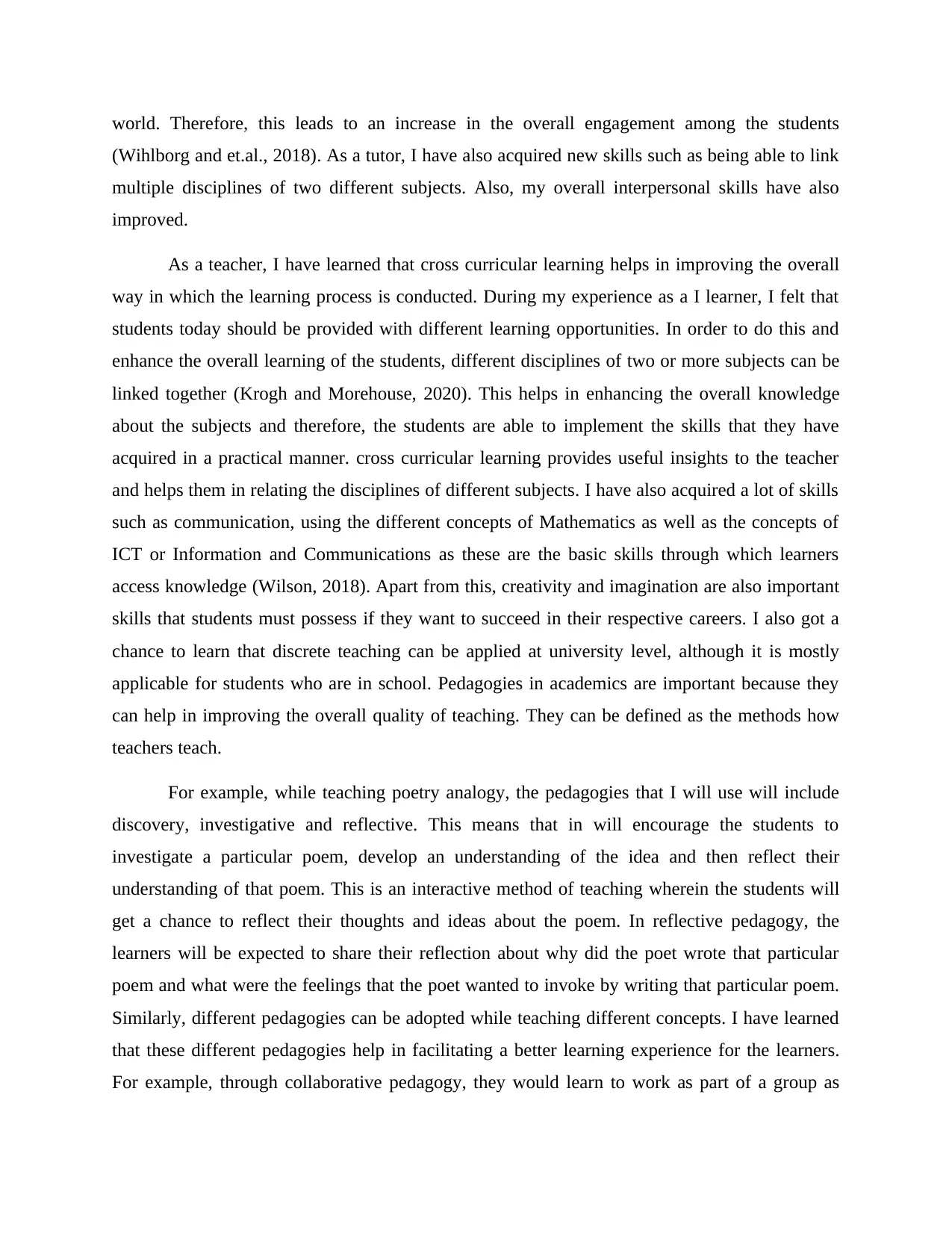
world. Therefore, this leads to an increase in the overall engagement among the students
(Wihlborg and et.al., 2018). As a tutor, I have also acquired new skills such as being able to link
multiple disciplines of two different subjects. Also, my overall interpersonal skills have also
improved.
As a teacher, I have learned that cross curricular learning helps in improving the overall
way in which the learning process is conducted. During my experience as a I learner, I felt that
students today should be provided with different learning opportunities. In order to do this and
enhance the overall learning of the students, different disciplines of two or more subjects can be
linked together (Krogh and Morehouse, 2020). This helps in enhancing the overall knowledge
about the subjects and therefore, the students are able to implement the skills that they have
acquired in a practical manner. cross curricular learning provides useful insights to the teacher
and helps them in relating the disciplines of different subjects. I have also acquired a lot of skills
such as communication, using the different concepts of Mathematics as well as the concepts of
ICT or Information and Communications as these are the basic skills through which learners
access knowledge (Wilson, 2018). Apart from this, creativity and imagination are also important
skills that students must possess if they want to succeed in their respective careers. I also got a
chance to learn that discrete teaching can be applied at university level, although it is mostly
applicable for students who are in school. Pedagogies in academics are important because they
can help in improving the overall quality of teaching. They can be defined as the methods how
teachers teach.
For example, while teaching poetry analogy, the pedagogies that I will use will include
discovery, investigative and reflective. This means that in will encourage the students to
investigate a particular poem, develop an understanding of the idea and then reflect their
understanding of that poem. This is an interactive method of teaching wherein the students will
get a chance to reflect their thoughts and ideas about the poem. In reflective pedagogy, the
learners will be expected to share their reflection about why did the poet wrote that particular
poem and what were the feelings that the poet wanted to invoke by writing that particular poem.
Similarly, different pedagogies can be adopted while teaching different concepts. I have learned
that these different pedagogies help in facilitating a better learning experience for the learners.
For example, through collaborative pedagogy, they would learn to work as part of a group as
(Wihlborg and et.al., 2018). As a tutor, I have also acquired new skills such as being able to link
multiple disciplines of two different subjects. Also, my overall interpersonal skills have also
improved.
As a teacher, I have learned that cross curricular learning helps in improving the overall
way in which the learning process is conducted. During my experience as a I learner, I felt that
students today should be provided with different learning opportunities. In order to do this and
enhance the overall learning of the students, different disciplines of two or more subjects can be
linked together (Krogh and Morehouse, 2020). This helps in enhancing the overall knowledge
about the subjects and therefore, the students are able to implement the skills that they have
acquired in a practical manner. cross curricular learning provides useful insights to the teacher
and helps them in relating the disciplines of different subjects. I have also acquired a lot of skills
such as communication, using the different concepts of Mathematics as well as the concepts of
ICT or Information and Communications as these are the basic skills through which learners
access knowledge (Wilson, 2018). Apart from this, creativity and imagination are also important
skills that students must possess if they want to succeed in their respective careers. I also got a
chance to learn that discrete teaching can be applied at university level, although it is mostly
applicable for students who are in school. Pedagogies in academics are important because they
can help in improving the overall quality of teaching. They can be defined as the methods how
teachers teach.
For example, while teaching poetry analogy, the pedagogies that I will use will include
discovery, investigative and reflective. This means that in will encourage the students to
investigate a particular poem, develop an understanding of the idea and then reflect their
understanding of that poem. This is an interactive method of teaching wherein the students will
get a chance to reflect their thoughts and ideas about the poem. In reflective pedagogy, the
learners will be expected to share their reflection about why did the poet wrote that particular
poem and what were the feelings that the poet wanted to invoke by writing that particular poem.
Similarly, different pedagogies can be adopted while teaching different concepts. I have learned
that these different pedagogies help in facilitating a better learning experience for the learners.
For example, through collaborative pedagogy, they would learn to work as part of a group as
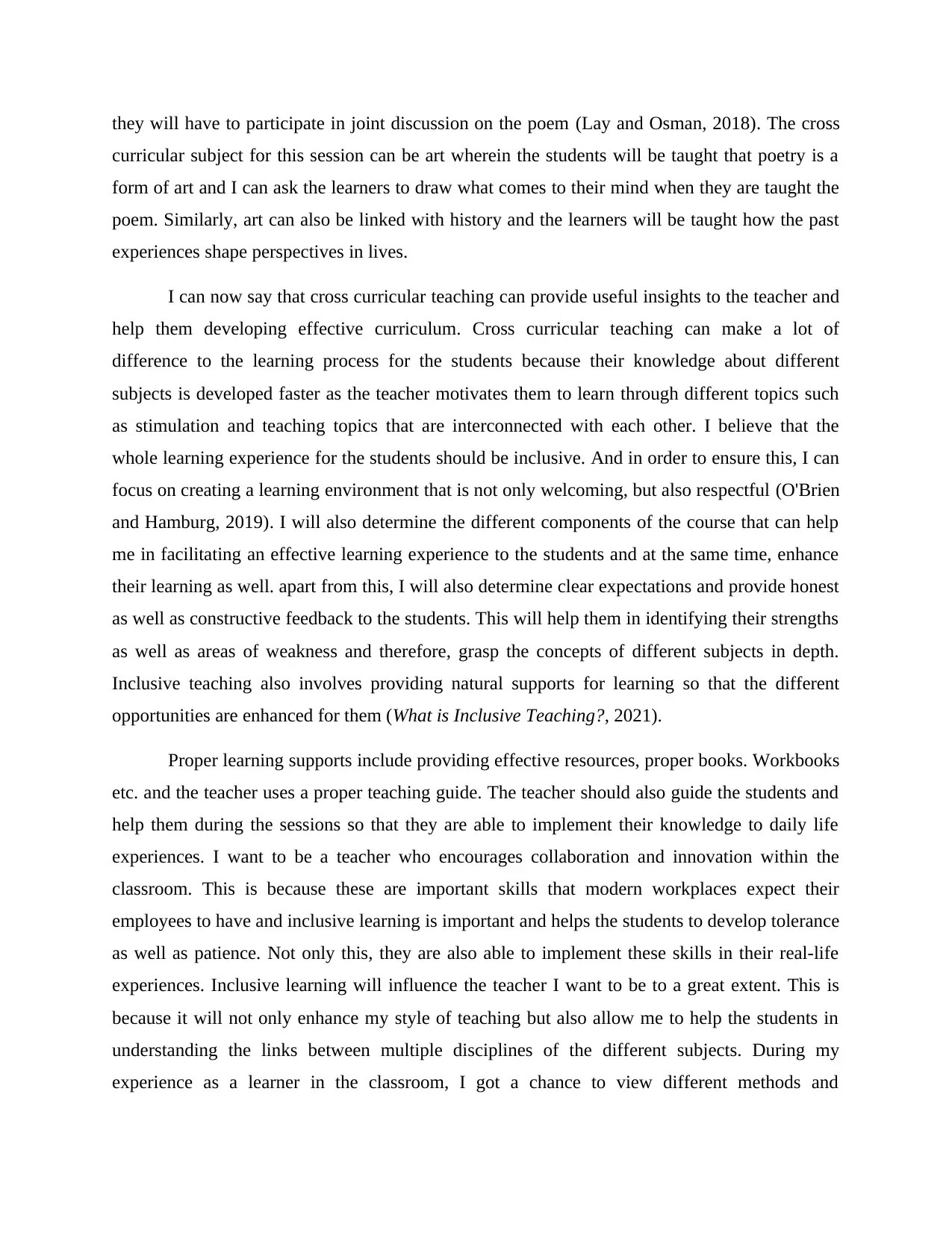
they will have to participate in joint discussion on the poem (Lay and Osman, 2018). The cross
curricular subject for this session can be art wherein the students will be taught that poetry is a
form of art and I can ask the learners to draw what comes to their mind when they are taught the
poem. Similarly, art can also be linked with history and the learners will be taught how the past
experiences shape perspectives in lives.
I can now say that cross curricular teaching can provide useful insights to the teacher and
help them developing effective curriculum. Cross curricular teaching can make a lot of
difference to the learning process for the students because their knowledge about different
subjects is developed faster as the teacher motivates them to learn through different topics such
as stimulation and teaching topics that are interconnected with each other. I believe that the
whole learning experience for the students should be inclusive. And in order to ensure this, I can
focus on creating a learning environment that is not only welcoming, but also respectful (O'Brien
and Hamburg, 2019). I will also determine the different components of the course that can help
me in facilitating an effective learning experience to the students and at the same time, enhance
their learning as well. apart from this, I will also determine clear expectations and provide honest
as well as constructive feedback to the students. This will help them in identifying their strengths
as well as areas of weakness and therefore, grasp the concepts of different subjects in depth.
Inclusive teaching also involves providing natural supports for learning so that the different
opportunities are enhanced for them (What is Inclusive Teaching?, 2021).
Proper learning supports include providing effective resources, proper books. Workbooks
etc. and the teacher uses a proper teaching guide. The teacher should also guide the students and
help them during the sessions so that they are able to implement their knowledge to daily life
experiences. I want to be a teacher who encourages collaboration and innovation within the
classroom. This is because these are important skills that modern workplaces expect their
employees to have and inclusive learning is important and helps the students to develop tolerance
as well as patience. Not only this, they are also able to implement these skills in their real-life
experiences. Inclusive learning will influence the teacher I want to be to a great extent. This is
because it will not only enhance my style of teaching but also allow me to help the students in
understanding the links between multiple disciplines of the different subjects. During my
experience as a learner in the classroom, I got a chance to view different methods and
curricular subject for this session can be art wherein the students will be taught that poetry is a
form of art and I can ask the learners to draw what comes to their mind when they are taught the
poem. Similarly, art can also be linked with history and the learners will be taught how the past
experiences shape perspectives in lives.
I can now say that cross curricular teaching can provide useful insights to the teacher and
help them developing effective curriculum. Cross curricular teaching can make a lot of
difference to the learning process for the students because their knowledge about different
subjects is developed faster as the teacher motivates them to learn through different topics such
as stimulation and teaching topics that are interconnected with each other. I believe that the
whole learning experience for the students should be inclusive. And in order to ensure this, I can
focus on creating a learning environment that is not only welcoming, but also respectful (O'Brien
and Hamburg, 2019). I will also determine the different components of the course that can help
me in facilitating an effective learning experience to the students and at the same time, enhance
their learning as well. apart from this, I will also determine clear expectations and provide honest
as well as constructive feedback to the students. This will help them in identifying their strengths
as well as areas of weakness and therefore, grasp the concepts of different subjects in depth.
Inclusive teaching also involves providing natural supports for learning so that the different
opportunities are enhanced for them (What is Inclusive Teaching?, 2021).
Proper learning supports include providing effective resources, proper books. Workbooks
etc. and the teacher uses a proper teaching guide. The teacher should also guide the students and
help them during the sessions so that they are able to implement their knowledge to daily life
experiences. I want to be a teacher who encourages collaboration and innovation within the
classroom. This is because these are important skills that modern workplaces expect their
employees to have and inclusive learning is important and helps the students to develop tolerance
as well as patience. Not only this, they are also able to implement these skills in their real-life
experiences. Inclusive learning will influence the teacher I want to be to a great extent. This is
because it will not only enhance my style of teaching but also allow me to help the students in
understanding the links between multiple disciplines of the different subjects. During my
experience as a learner in the classroom, I got a chance to view different methods and
⊘ This is a preview!⊘
Do you want full access?
Subscribe today to unlock all pages.

Trusted by 1+ million students worldwide
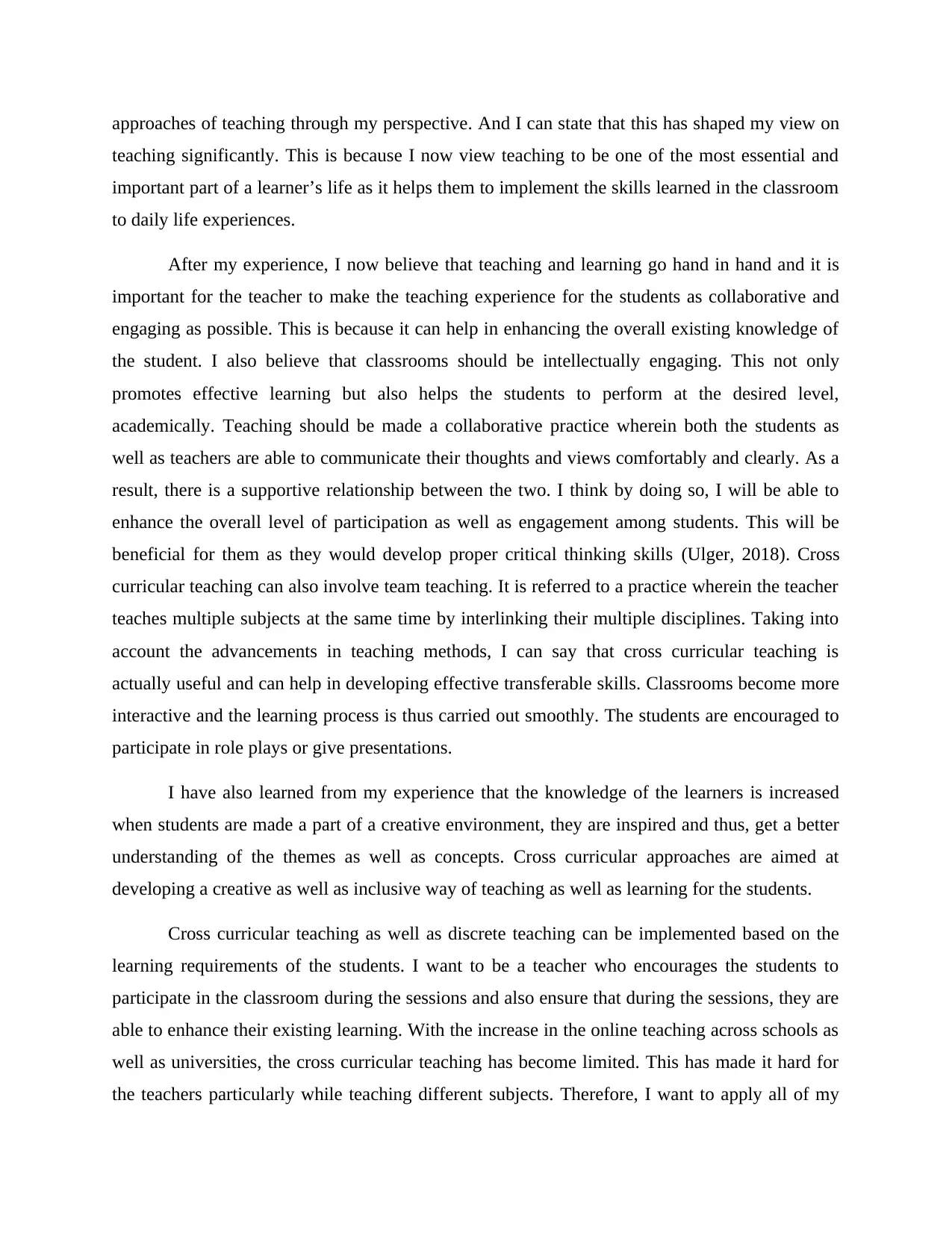
approaches of teaching through my perspective. And I can state that this has shaped my view on
teaching significantly. This is because I now view teaching to be one of the most essential and
important part of a learner’s life as it helps them to implement the skills learned in the classroom
to daily life experiences.
After my experience, I now believe that teaching and learning go hand in hand and it is
important for the teacher to make the teaching experience for the students as collaborative and
engaging as possible. This is because it can help in enhancing the overall existing knowledge of
the student. I also believe that classrooms should be intellectually engaging. This not only
promotes effective learning but also helps the students to perform at the desired level,
academically. Teaching should be made a collaborative practice wherein both the students as
well as teachers are able to communicate their thoughts and views comfortably and clearly. As a
result, there is a supportive relationship between the two. I think by doing so, I will be able to
enhance the overall level of participation as well as engagement among students. This will be
beneficial for them as they would develop proper critical thinking skills (Ulger, 2018). Cross
curricular teaching can also involve team teaching. It is referred to a practice wherein the teacher
teaches multiple subjects at the same time by interlinking their multiple disciplines. Taking into
account the advancements in teaching methods, I can say that cross curricular teaching is
actually useful and can help in developing effective transferable skills. Classrooms become more
interactive and the learning process is thus carried out smoothly. The students are encouraged to
participate in role plays or give presentations.
I have also learned from my experience that the knowledge of the learners is increased
when students are made a part of a creative environment, they are inspired and thus, get a better
understanding of the themes as well as concepts. Cross curricular approaches are aimed at
developing a creative as well as inclusive way of teaching as well as learning for the students.
Cross curricular teaching as well as discrete teaching can be implemented based on the
learning requirements of the students. I want to be a teacher who encourages the students to
participate in the classroom during the sessions and also ensure that during the sessions, they are
able to enhance their existing learning. With the increase in the online teaching across schools as
well as universities, the cross curricular teaching has become limited. This has made it hard for
the teachers particularly while teaching different subjects. Therefore, I want to apply all of my
teaching significantly. This is because I now view teaching to be one of the most essential and
important part of a learner’s life as it helps them to implement the skills learned in the classroom
to daily life experiences.
After my experience, I now believe that teaching and learning go hand in hand and it is
important for the teacher to make the teaching experience for the students as collaborative and
engaging as possible. This is because it can help in enhancing the overall existing knowledge of
the student. I also believe that classrooms should be intellectually engaging. This not only
promotes effective learning but also helps the students to perform at the desired level,
academically. Teaching should be made a collaborative practice wherein both the students as
well as teachers are able to communicate their thoughts and views comfortably and clearly. As a
result, there is a supportive relationship between the two. I think by doing so, I will be able to
enhance the overall level of participation as well as engagement among students. This will be
beneficial for them as they would develop proper critical thinking skills (Ulger, 2018). Cross
curricular teaching can also involve team teaching. It is referred to a practice wherein the teacher
teaches multiple subjects at the same time by interlinking their multiple disciplines. Taking into
account the advancements in teaching methods, I can say that cross curricular teaching is
actually useful and can help in developing effective transferable skills. Classrooms become more
interactive and the learning process is thus carried out smoothly. The students are encouraged to
participate in role plays or give presentations.
I have also learned from my experience that the knowledge of the learners is increased
when students are made a part of a creative environment, they are inspired and thus, get a better
understanding of the themes as well as concepts. Cross curricular approaches are aimed at
developing a creative as well as inclusive way of teaching as well as learning for the students.
Cross curricular teaching as well as discrete teaching can be implemented based on the
learning requirements of the students. I want to be a teacher who encourages the students to
participate in the classroom during the sessions and also ensure that during the sessions, they are
able to enhance their existing learning. With the increase in the online teaching across schools as
well as universities, the cross curricular teaching has become limited. This has made it hard for
the teachers particularly while teaching different subjects. Therefore, I want to apply all of my
Paraphrase This Document
Need a fresh take? Get an instant paraphrase of this document with our AI Paraphraser
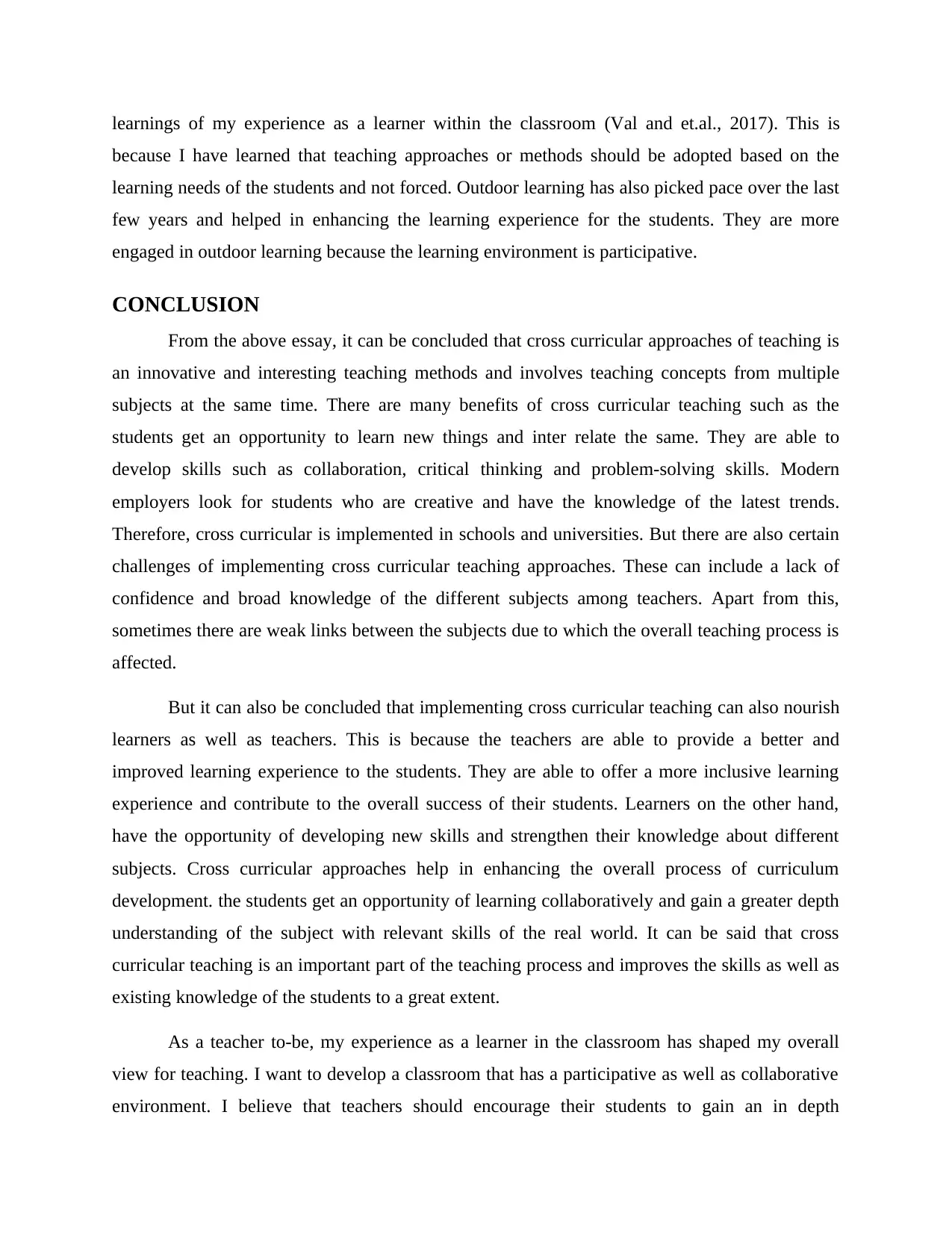
learnings of my experience as a learner within the classroom (Val and et.al., 2017). This is
because I have learned that teaching approaches or methods should be adopted based on the
learning needs of the students and not forced. Outdoor learning has also picked pace over the last
few years and helped in enhancing the learning experience for the students. They are more
engaged in outdoor learning because the learning environment is participative.
CONCLUSION
From the above essay, it can be concluded that cross curricular approaches of teaching is
an innovative and interesting teaching methods and involves teaching concepts from multiple
subjects at the same time. There are many benefits of cross curricular teaching such as the
students get an opportunity to learn new things and inter relate the same. They are able to
develop skills such as collaboration, critical thinking and problem-solving skills. Modern
employers look for students who are creative and have the knowledge of the latest trends.
Therefore, cross curricular is implemented in schools and universities. But there are also certain
challenges of implementing cross curricular teaching approaches. These can include a lack of
confidence and broad knowledge of the different subjects among teachers. Apart from this,
sometimes there are weak links between the subjects due to which the overall teaching process is
affected.
But it can also be concluded that implementing cross curricular teaching can also nourish
learners as well as teachers. This is because the teachers are able to provide a better and
improved learning experience to the students. They are able to offer a more inclusive learning
experience and contribute to the overall success of their students. Learners on the other hand,
have the opportunity of developing new skills and strengthen their knowledge about different
subjects. Cross curricular approaches help in enhancing the overall process of curriculum
development. the students get an opportunity of learning collaboratively and gain a greater depth
understanding of the subject with relevant skills of the real world. It can be said that cross
curricular teaching is an important part of the teaching process and improves the skills as well as
existing knowledge of the students to a great extent.
As a teacher to-be, my experience as a learner in the classroom has shaped my overall
view for teaching. I want to develop a classroom that has a participative as well as collaborative
environment. I believe that teachers should encourage their students to gain an in depth
because I have learned that teaching approaches or methods should be adopted based on the
learning needs of the students and not forced. Outdoor learning has also picked pace over the last
few years and helped in enhancing the learning experience for the students. They are more
engaged in outdoor learning because the learning environment is participative.
CONCLUSION
From the above essay, it can be concluded that cross curricular approaches of teaching is
an innovative and interesting teaching methods and involves teaching concepts from multiple
subjects at the same time. There are many benefits of cross curricular teaching such as the
students get an opportunity to learn new things and inter relate the same. They are able to
develop skills such as collaboration, critical thinking and problem-solving skills. Modern
employers look for students who are creative and have the knowledge of the latest trends.
Therefore, cross curricular is implemented in schools and universities. But there are also certain
challenges of implementing cross curricular teaching approaches. These can include a lack of
confidence and broad knowledge of the different subjects among teachers. Apart from this,
sometimes there are weak links between the subjects due to which the overall teaching process is
affected.
But it can also be concluded that implementing cross curricular teaching can also nourish
learners as well as teachers. This is because the teachers are able to provide a better and
improved learning experience to the students. They are able to offer a more inclusive learning
experience and contribute to the overall success of their students. Learners on the other hand,
have the opportunity of developing new skills and strengthen their knowledge about different
subjects. Cross curricular approaches help in enhancing the overall process of curriculum
development. the students get an opportunity of learning collaboratively and gain a greater depth
understanding of the subject with relevant skills of the real world. It can be said that cross
curricular teaching is an important part of the teaching process and improves the skills as well as
existing knowledge of the students to a great extent.
As a teacher to-be, my experience as a learner in the classroom has shaped my overall
view for teaching. I want to develop a classroom that has a participative as well as collaborative
environment. I believe that teachers should encourage their students to gain an in depth
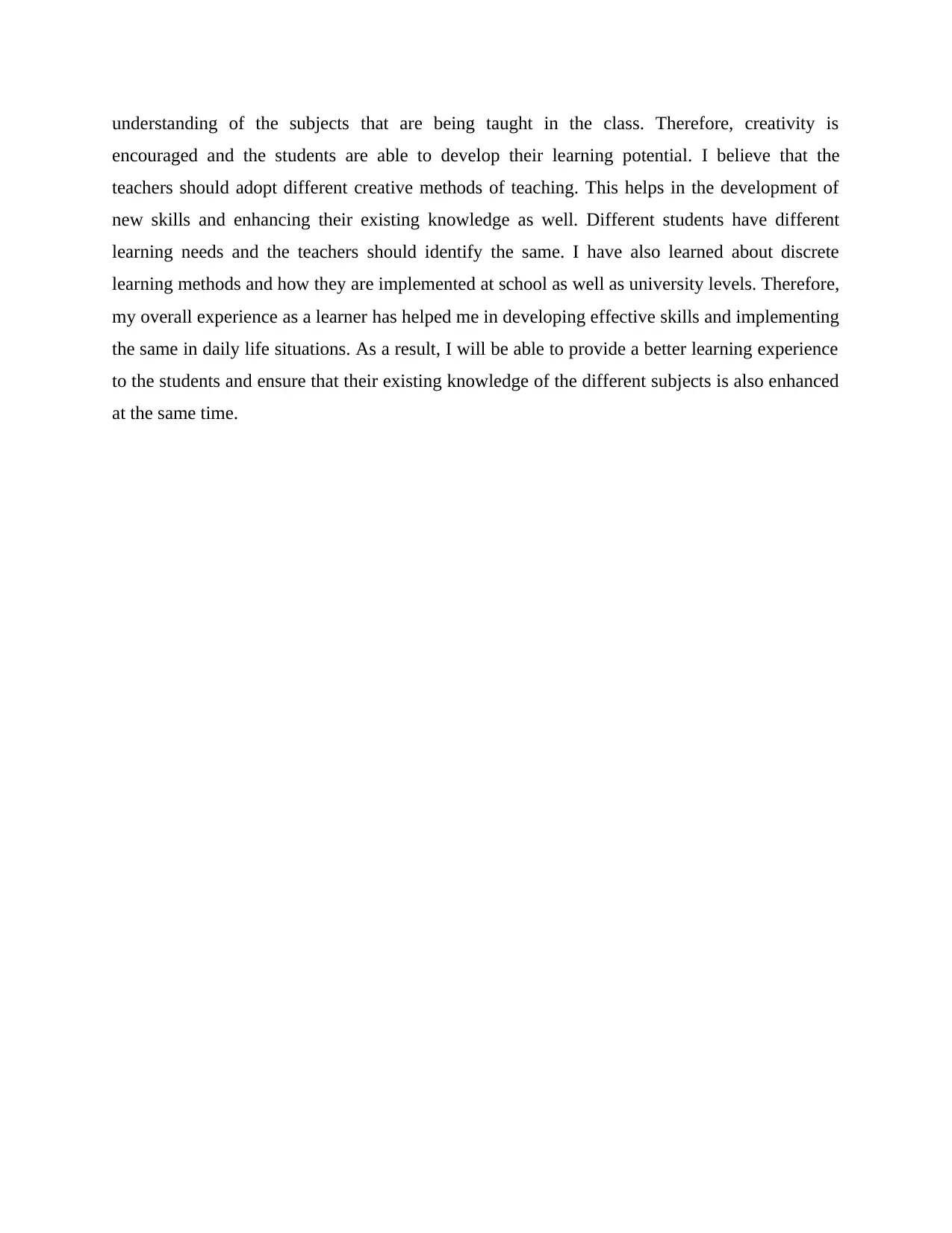
understanding of the subjects that are being taught in the class. Therefore, creativity is
encouraged and the students are able to develop their learning potential. I believe that the
teachers should adopt different creative methods of teaching. This helps in the development of
new skills and enhancing their existing knowledge as well. Different students have different
learning needs and the teachers should identify the same. I have also learned about discrete
learning methods and how they are implemented at school as well as university levels. Therefore,
my overall experience as a learner has helped me in developing effective skills and implementing
the same in daily life situations. As a result, I will be able to provide a better learning experience
to the students and ensure that their existing knowledge of the different subjects is also enhanced
at the same time.
encouraged and the students are able to develop their learning potential. I believe that the
teachers should adopt different creative methods of teaching. This helps in the development of
new skills and enhancing their existing knowledge as well. Different students have different
learning needs and the teachers should identify the same. I have also learned about discrete
learning methods and how they are implemented at school as well as university levels. Therefore,
my overall experience as a learner has helped me in developing effective skills and implementing
the same in daily life situations. As a result, I will be able to provide a better learning experience
to the students and ensure that their existing knowledge of the different subjects is also enhanced
at the same time.
⊘ This is a preview!⊘
Do you want full access?
Subscribe today to unlock all pages.

Trusted by 1+ million students worldwide
1 out of 14
Related Documents
Your All-in-One AI-Powered Toolkit for Academic Success.
+13062052269
info@desklib.com
Available 24*7 on WhatsApp / Email
![[object Object]](/_next/static/media/star-bottom.7253800d.svg)
Unlock your academic potential
Copyright © 2020–2025 A2Z Services. All Rights Reserved. Developed and managed by ZUCOL.





